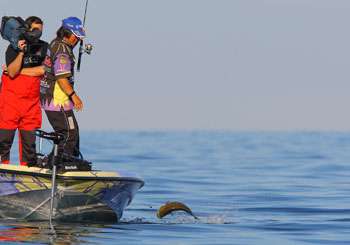
Japanese anglers are a remarkable group. In a land of highly pressured small lakes and fierce competition, they've produced some of the most enthusiastic and talented tournament anglers in the world. And, because of that pressure, limited access and competition, they're some of the most innovative, as well.
The sport of bass fishing has benefited from that innovative spirit in the form of super-realistic lure designs and fantastic finesse techniques such as drop shotting.
Within the last couple of years, another Japanese finesse technique has slowly begun to capture the attention of the bass world — the wacky jig.
The set up for proper wacky jigging seems conventional. However, Curt Arakawa of Jackall Lures, creators of the Flickshake worm and Wacky Jighead, says that anglers "think it's the same thing they've seen before, and it's not"
"Some guys make jigs, some make worms," he continues. "We make both to work as a system."
The technique is as simple as the standard wacky worm technique. The difference is how the jig and worm work together to produce erratic, lifelike action.
Per Curt, "The jig is specially designed for use with the Flickshake worm. It has a tungsten head that is smaller and heavier than lead for more energy. It has a shorter Owner hook with no keeper and the eye is at a 90-degree angle from the hook."
"The design brings the hook right up into the upper jaw of the fish," he adds. "The hook set is by pressure. Just start reeling to set the hook."
Curt describes the Flickshake worm as being "flexible and with great action. It's a softer, salt-injected plastic with a profound curve that creates the unbalanced, erratic action."
"Also," says Curt, "the egg sac is positioned in the middle of the bait which tells fishermen exactly where to put the hook."
Simply inserting the hook through the middle of the egg sac at a ninety-degree angle rigs the worm.
The importance of rigging correctly is that it is the pendulum action of the weight as it falls that produces the bass attracting action of the worm.
Curt strongly believes in the future of the wacky jig and predicts, "The guys that wait are going to miss out on it."
Kotaro Kiriyama, Elite Series pro, has made three Classic appearances and has a slew of top ten finishes under his belt. He's a master at the wacky jig technique and has been fishing it successfully for two years.
According to Kiriyama, success with the technique depends on using the right outfit and line. He relies on a light action spinning rod with a fast taper and recommends 6- to 10-pound Gamma fluorocarbon line.
"If you use the right equipment," he says, "you'll notice more bites. Experiment until you find the right combination for you, your waters and the particular conditions you're facing. It makes that much difference."
Kiriyama's advice is to throw the jig like any other fall bait such as a Yamamoto Senko or Yum Dinger.
"Cast it and just do nothing, leave it" he counsels, "There's magic in there. The key is to cast and do not move the bait. Let the rig do the action."
Echoing Arakawa, Kiriyama says, "The jig head makes the bait unbalanced with a weird wobble on the fall."
After the cast, be sure to leave slack in the line as the bait falls. Watch carefully for the sudden twitch or sideways movement of the line. Most hits come on the fall. On the retrieve, impart some subtle twitches with the rod tip to start the erratic worm action and make that curious hawg commit.
Kiriyama's last words probably say it all about the future of this technique, "I wish I were able to use it without other people using it for the next couple of years," he says smiling. "Once people get to use it, it will go all over the place."




